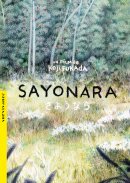
016 // Sayonara
Kôji Fukada
// Japon // 2015
// 112 min // Couleur // 1,85:1
It is the near future, Japan has become contaminated with massive amounts of radiation. With 80% of Japan severely contaminated, the government makes an official decision to abandon the country and begin evacuating residents by lots. Left behind in the swelling exodus is a South African expatriate, Tanya, and her android caretaker, Leona. As people pass them by, the two are left alone together to contemplate life and death, and the distinction between robot and human. What separates them? What meaning does “life” and “death” carry for humans and robots, respectively?
presentation
Sayonara is the collaborative brainchild of noted Japanese playwright, Oriza Hirata, and leading robotics engineer, Hiroshi Ishiguro (Osaka University Graduate School of Engineering) who have fused art and science to bring the world its first acting duo starring a human and a robot.
After the original stage production of Sayonara premiered in Tokyo and Osaka, it went overseas to Austria and France to great acclaim and continues to be in high demand for showings around the world. The stage version is being adapted to feature film format for the very first time.
The central character of the android Leona is played by a very human-like robot, Geminoid F, developed by Hiroshi Ishiguro. Her counterpart, Tanya, is a human who lives with the android, and is played by Bryerly Long, reprising her stage role. The unique duo is bolstered by a strong support cast of top Japanese acting talent including Hirofumi Arai, Nijiro Murakami.
director's statement
It would be hard for me to forget the excitement I perceived upon first watching the android theatre Sayonara. It was fascinating because it was the first demonstration in the world of a robot and a human actor performing naturally together on stage. Further, in contrast to typical associations with robots, this play relied on the extremely human medium of poetry; and this contrast was both striking and highly effective. Of course, it was not simply a unique demonstration; but the extremely developed gestures of the robot, and the quality of the acting of both the robot and her human counterpart that made the play very moving and enjoyable to watch on its own accord.
However, in this piece of theatre with various strong qualities, what struck me most was how a quiet impression of death was communicated to the audience. The difference between humans and animals is their consciousness of death. So how does that apply in the case of android robots? The android, which has cared for the girl over the years almost like a daughter, sits watching her dying with a calm face, not grasping what is happening. In this gaze of the android I see the tragedy of modern people.
Regardless of the strong logic of science, which allows us to understand the way the world is made up and the biological processes which occur until our death, and which can sometimes prolong human life; science cannot describe the world after death to us. Religion used to fill the role of providing people with spiritual support in the face of death. However for many modern people neither religion nor science can completely explain death. It seems to me that the gaze of the android on the dying girl represents the tragedy that modern people experience in the face of death.
We will all die: be it from disease, or an accident, or a natural disaster. Death will necessarily come to find us. Over thousands of years, art has struggled ahead of the incomprehensible phenomenon of death. Thanks to artefacts that artists have left to us, people can apprehend the concept of death whilst they are still alive, and little by little accept death within their perception of the world.
When I decided to make this conversation between a robot and a human being into a film, I thought it was necessary to create an extreme disaster situation, from which humans cannot escape. When I thought about a real situation, which expresses this kind of apocalyptic circumstance, the immensity of the nuclear disaster of 2011, and the situation of people who could not escape from radiation, came to mind. I though that this is the most realistic situation in which people face the inevitability of death from a disaster that they cannot escape. In that sense, this film is not a piece of science fiction. The most excellent science fiction artists can sometimes predict aspects of the future; but the catastrophe described in this film is one that anybody alive today could imagine.
Koji Fukada
Koji Fukada was born in 1980, Tokyo, Japan. His first film The Chair was released in Tokyo in 2004. He joined the Theatre Company Seinendan, which is led by Oriza Hirata, in 2005.
Koji Fukada has already earned global attention as budding film writer and director. His list of achievements include: Best in the Japanese Eyes Section of the 2010 Tokyo International Film Festival and NETPAC Award at the 2011 Pucheon International Fantastic Film Festival for Filmhis 2010 film Hospitalité; the Audience Award and Golden Montgolfiere (jury award) at the 2013 Nantes Three Continents Festival for Au revoir l’été - and Best Director award at the 2013 Tallinn Black Nights Film Festival for the same film. Based on playwright Oriza Hirata theatrical production Sayonara II, his last film, Sayonara, got its world premiere at the Tokyo International Film Festival in 2015.
18€





